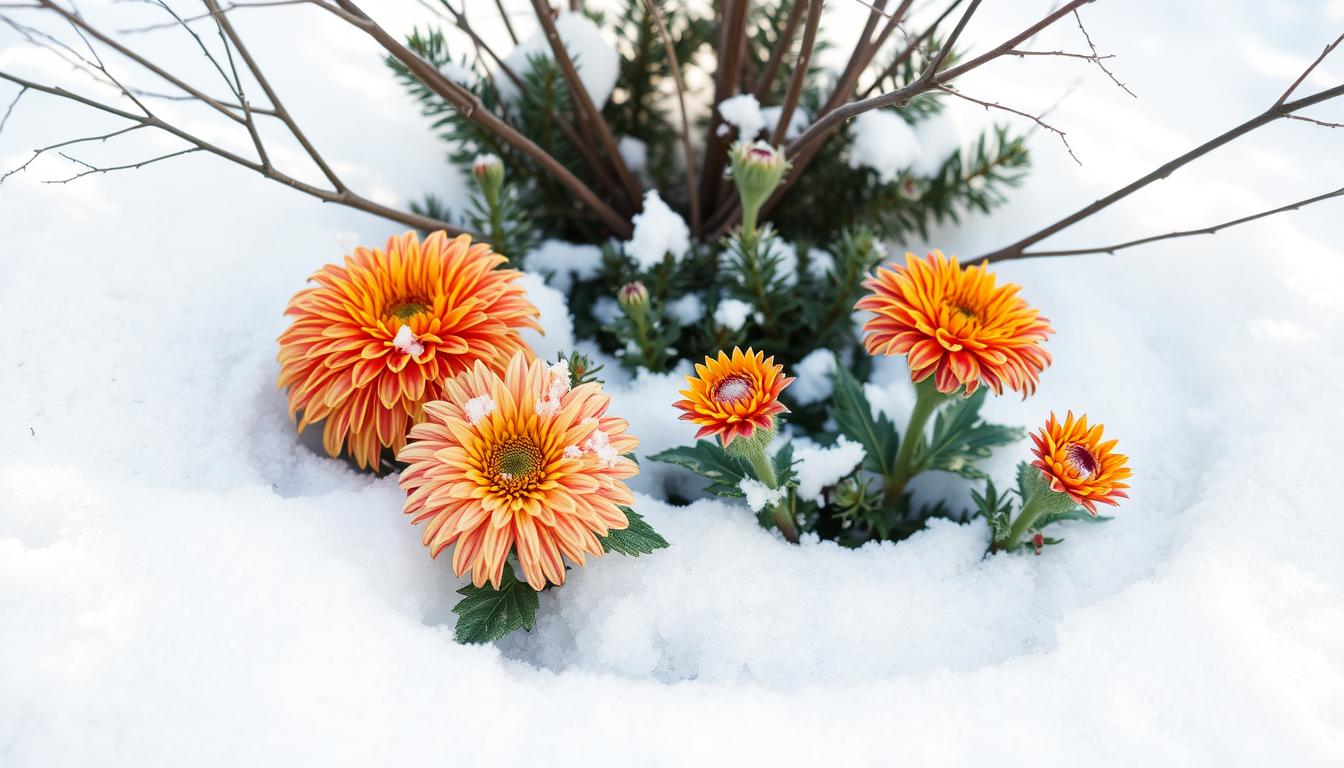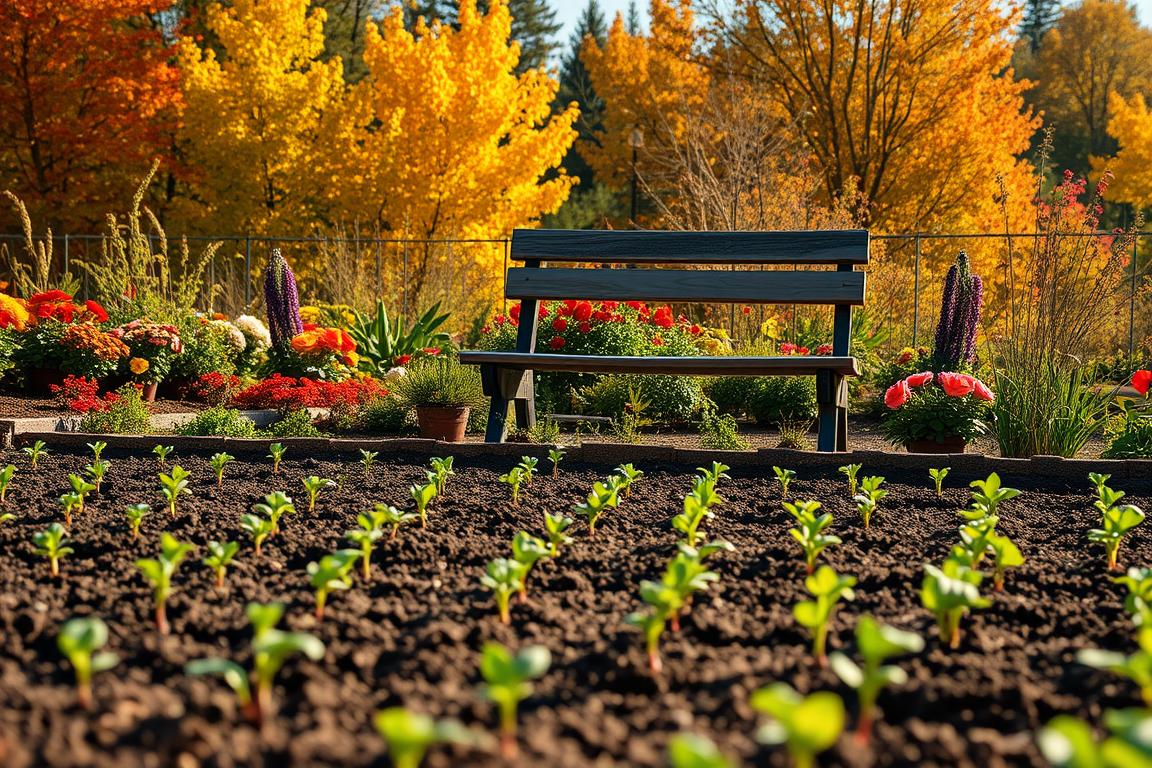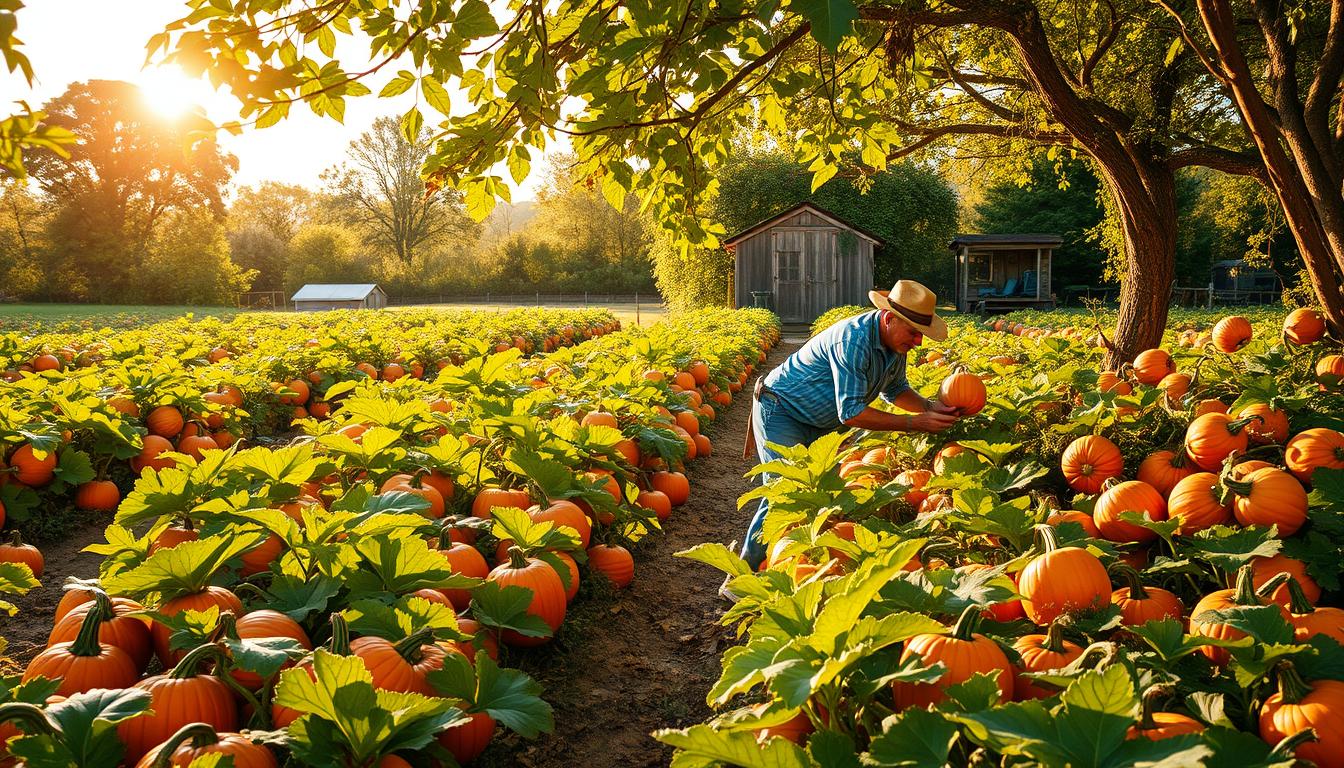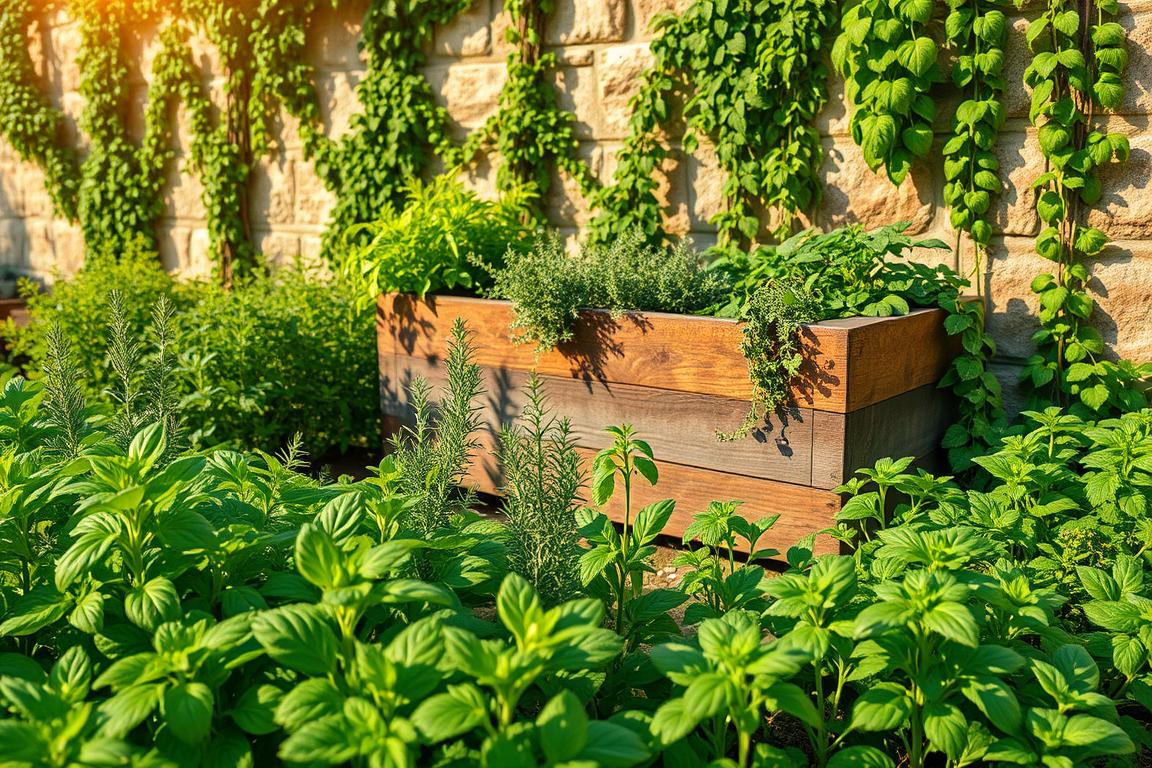As winter approaches, gardeners must protect their mums from cold. These hardy plants are known for their bright flowers and ability to survive the cold. Knowing how to care for them is key to keeping them alive and blooming.
Mums can handle many climates but need special care in winter. They don’t like frost but do well in cooler weather. With the right care, like deadheading and winter protection, mums can make it through the cold and bloom again in spring.
Key Takeaways
- Mums are perennials that can survive the winter with proper care and preparation.
- Choose between bud or blooming mums based on your desired flowering time.
- Cooler weather prolongs the life of mum blooms, while heat can cause flowers to fade faster.
- Deadheading can encourage a second flush of blooms on mums.
- Specific winter care techniques, such as cutting back, mulching, and proper watering, are essential for mums to survive the colder months.
Understanding Hardy vs. Florist Mums: Which Variety Survives Winter
It’s important to know the difference between hardy garden mums and florist mums. Hardy mums can handle cold weather, while florist mums can’t.
Identifying Hardy Garden Mums
Hardy garden mums are perennials that come back every year. They add color to your garden in the fall. These plants grow 1 to 3 feet tall and 1 to 2 feet wide.
They bloom for up to 8 weeks, from late summer to fall.
Why Florist Mums Don't Survive Winter
Florist mums are annuals that can’t handle cold weather. They grow well in USDA zones 7 to 9. Florist mums focus on lots of blooms, not on being strong enough for winter.
Best Hardy Mum Varieties for Cold Climates
For gardeners in cold areas, there are great cold-tolerant mum cultivars. The University of Minnesota-bred mums are good for zone 3. The Morden Mum series from Canada also does well in zone 3.
“Hardy mums are winter-hardy in USDA Zones 4 to 9, providing vivid color year after year.”
How to Keep Mums Alive Over the Winter
As winter approaches, it’s important to protect your chrysanthemums (or “mums”). Whether they’re in pots or your garden, a few steps can help them thrive. These tips will keep your mums blooming and safe from winter’s cold.
Timing the Cutback
Wait for the first frost to cut your mums back. Cut them to 1-2 inches above the soil. This helps them focus on growing strong roots instead of leaves during winter.
Overwintering Potted Mums
Move potted mums to a cool, safe spot like a garage or shed. Cover the pots with 3 inches of mulch and use an old sheet or burlap to keep them warm. Water them lightly every 2-3 weeks to keep the soil moist.
Protecting Garden-Planted Mums
Garden mums need extra care in winter. Apply a 3-4 inch layer of mulch around the base. Keep the soil moist but not too wet. Remove the mulch and dead leaves when spring comes.
Dividing for Rejuvenation
Divide your mums every other year to keep them healthy. This refreshes the roots and can even give you more plants.
By using these winterizing chrysanthemum plants and protecting chrysanthemums tips, your mums will make it through winter. They’ll come back with beautiful blooms next year.
Essential Fall Preparation Steps for Winter Protection
As autumn brings cooler air, it’s time to get our mums ready for winter. A few key steps in the fall can help them survive and even thrive through the cold months.
Timing Your Pre-Winter Cutback
It’s important to cut back mums to 1″ – 2″ above the soil after the first frost. This helps them focus on growing strong roots instead of keeping leaves.
Proper Mulching Techniques
- For potted mums, apply 3 inches of mulch and then move them to a cool place for winter.
- Landscaped mums need a 3″ to 4″ layer of mulch to protect their roots from cold weather.
Watering Guidelines Before Winter
Keeping mums moist is crucial for their survival. Make sure the soil is consistently moist but not too wet to avoid root rot. Plant mums by mid-October to give them time to establish roots before winter.
| Mum Variety | Sunlight Requirements | Bloom Time |
|---|---|---|
| Garden Mums | Full Sun (6+ hours) | Fall (October – November) |
| Florist Mums | Partial Shade | Late Summer – Fall |
By following these fall preparation steps, you can ensure your mums are winter-ready. With a bit of care, these colorful blooms will brighten your garden for years.
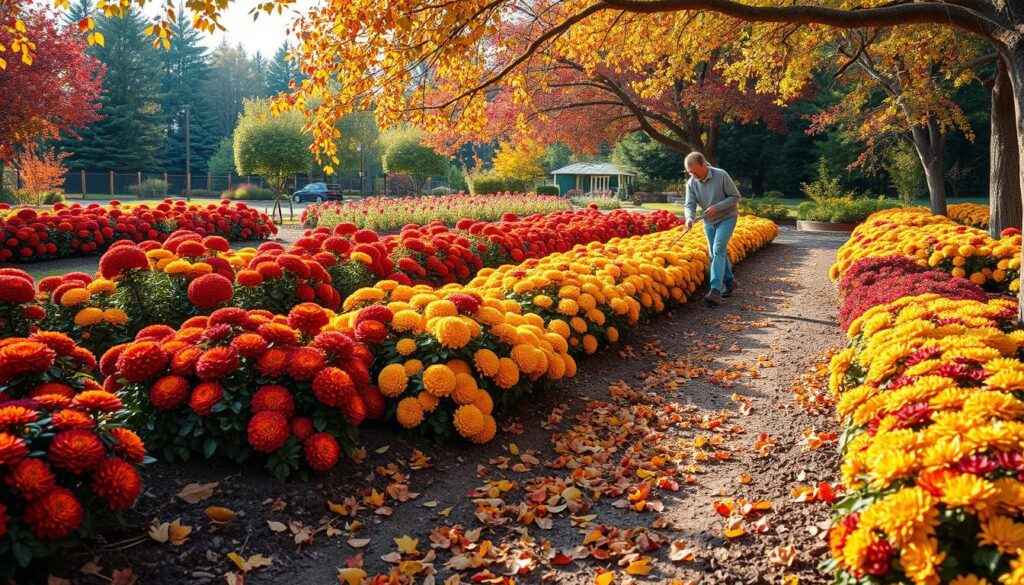
Indoor Winter Storage for Potted Mums
As winter gets closer, it’s time to think about how to keep your potted mums alive. Gardeners in zones colder than 4 or those who planted mums late in autumn need to bring them inside. After the first frost, carefully pot up your mums, making sure to get as much root as you can. Keep the leaves on to help them adjust to indoor life.
To keep your mums through winter, find a dark, cool spot. This could be an unheated basement or a cold closet. Water the soil lightly to keep it moist but not wet. Check the pots every week to make sure they’re not too dry. This will help your insulating potted mums rest until spring.
When it’s warm enough and the frost is gone, start to move your mums back outside. Do this slowly, giving them more light each day for a week or two. This will help them adjust and do well once they’re back outside.
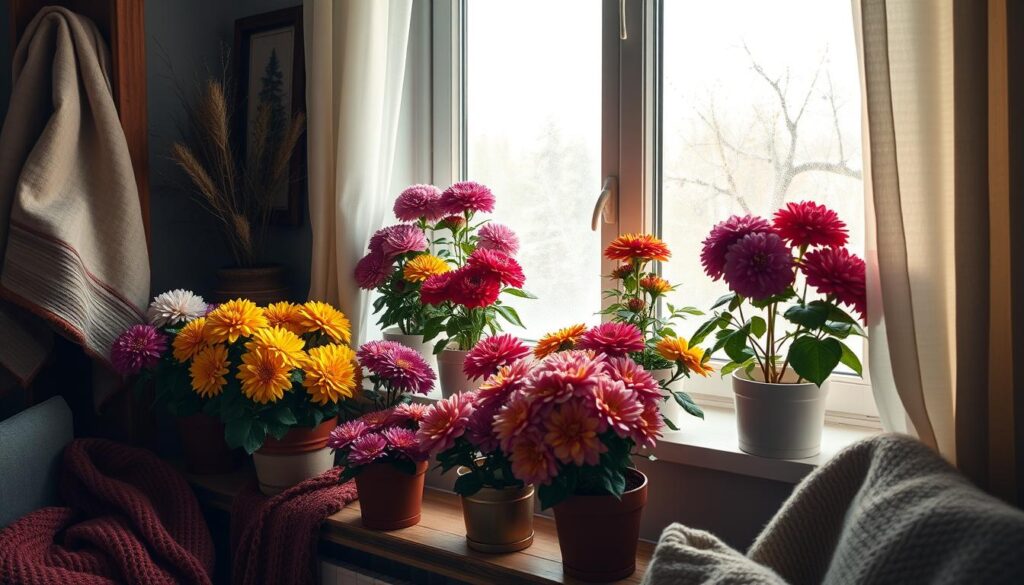
“Proper indoor storage is the key to keeping potted mums alive and healthy over the winter months.
By following these easy steps, you can keep your potted mums safe and healthy all winter. They’ll reward you with beautiful blooms and lush leaves in the spring.
Ground-Planted Mums: Winter Care Strategies
Keeping outdoor mum survival going can be tough. But, with the right dormant mum maintenance, your mum plant hardiness can last through winter. The trick is in the soil prep, mum winter mulching, and managing moisture.
Soil Preparation Methods
Begin by enriching your garden soil with organic matter. This improves drainage and adds nutrients. Mums do best in well-draining, slightly acidic soil with 6 hours of sunlight daily. Make sure your soil is ready for your mums before the first frost.
Protection Techniques for Garden Mums
After the first frost, trim your mum plants to 1-2 inches above the soil. Then, add a 3-4 inch mulch layer around the plants. This keeps the roots warm and moist, helping your mum plant hardiness survive winter.
Managing Winter Moisture Levels
Keep the soil moist around your dormant mum maintenance plants all winter. Check the soil often and water lightly as needed. This keeps the roots from drying out and ensures your mums bloom brightly in spring.
| Mum Planting and Care Tips | Recommendation |
|---|---|
| Ideal Planting Time | Late August to early September |
| Recommended Mulch Depth | 3-4 inches |
| Sunlight Exposure | 6 hours or more of direct sunlight |
| Overwintering in Pots | Move to a cold frame, greenhouse, or insulated garage |
By using these outdoor mum survival tips, your mum plant hardiness will thrive, even in harsh winters. Proper dormant mum maintenance and mum winter mulching ensure your garden mums bloom beautifully year after year.
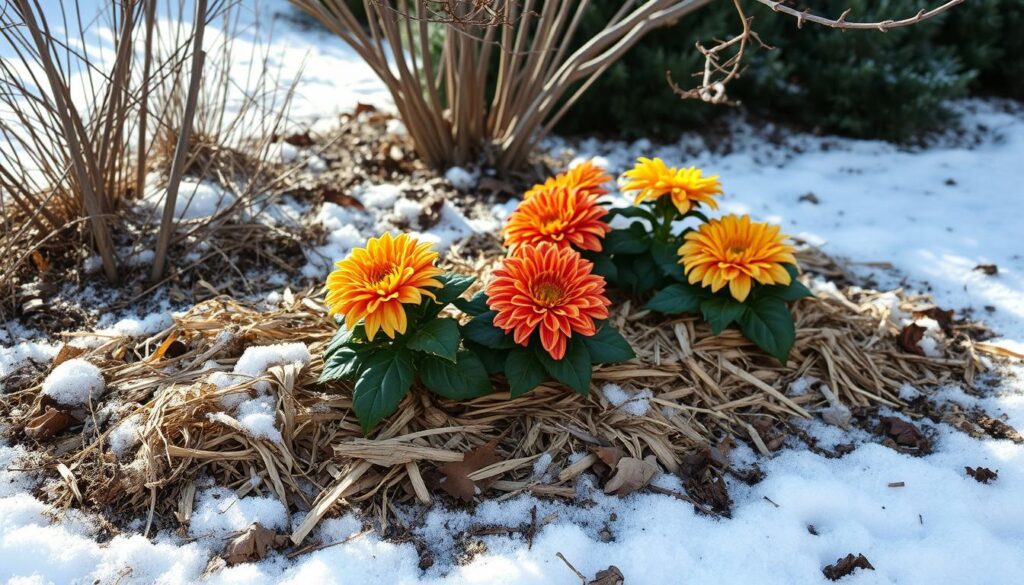
Spring Revival and Maintenance Tips
As winter fades and spring arrives, it’s time to care for your hardy garden mums. Whether you’re dealing with spring garden mum maintenance, the mum dormancy period, or prolonging mum blooms, these tips will help. They’re all about winter flower care to keep your mums looking great.
Start by removing mulch or covers when the ground is ready in spring. This lets the soil warm up and new growth to start. Then, use sharp pruners to cut back dead stems, leaving a few inches above the soil.
- Begin “pinching back” new growth when it’s 6 inches tall. Keep doing this every 5 inches until mid-July.
- This method makes your mums bushy and full, preparing for a beautiful fall bloom.
If your mums bloom in spring, enjoy them but remove the buds by early summer. This helps the plant grow more leaves and stems, leading to a great autumn display.
Feeding your mums is key in spring and summer. Use a balanced fertilizer in late spring and a bloom-boosting one in mid-summer. For potted mums, consider repotting them or planting them in the garden for better growth.
By following these spring garden mum maintenance tips, you can enjoy prolonging mum blooms. These hardy perennials will be a highlight of your garden all season.
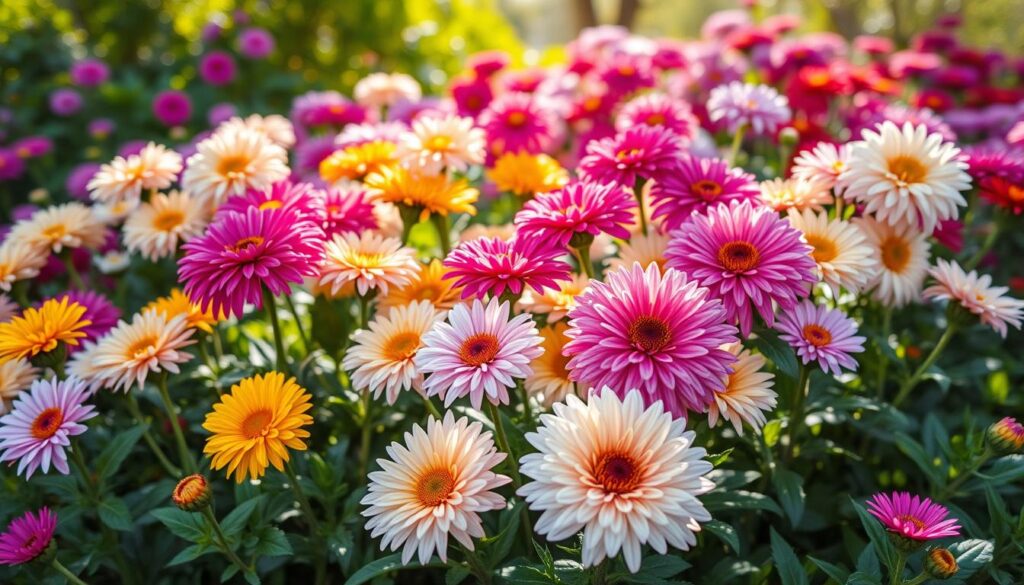
Conclusion
Hardy chrysanthemums can thrive through winter with the right care. They provide vibrant blooms year after year. Knowing the difference between hardy garden mums and florist varieties helps gardeners choose the best for their climate.
Effective chrysanthemum protection strategies are key. Following winter gardening tips like pre-winter cutback and mulching helps. Indoor storage for potted mums also extends their life and bloom quality.
Reviving and maintaining mums in spring ensures their survival. This way, gardeners can enjoy their mum plant survival and abundant blooms in future seasons.
Hardy chrysanthemums are great for garden beds, containers, or fall displays. They add color and texture to the landscape. With proper care, these resilient perennials will continue to thrive and delight gardeners for years.
FAQ
Q: What is the difference between hardy garden mums and florist mums?
A: Hardy garden mums are perennials that can survive winter. Florist mums are annuals that don’t do well in cold weather. Hardy mums have bigger flowers and are sold in bigger pots. Florist mums, on the other hand, are grown in greenhouses.
Q: What are some of the best hardy mum varieties for cold climates?
A: Korean mums, like ‘Sheffield’, are very hardy. University of Minnesota-bred mums can handle zone 3. These include compact and mammoth shrub mums. The Morden Mum series from Canada also thrives in zone 3.
Q: When is the best time to plant mums for winter survival?
A: For zones colder than 4, plant mums by mid-October. This lets them establish roots before winter. Make sure the soil is rich and drains well. The spot should get at least 6 hours of sunlight.
Q: How should I prepare mums for winter?
A: After the first frost, cut mums back to 1-2 inches above the soil. Then, add 3-4 inches of mulch for protection. For potted mums, add mulch and cover with a sheet. Move them to a cool garage. Keep all mums moist during winter.
Q: How do I care for potted mums over the winter?
A: Overwinter potted mums in a cool garage. Cover with 3 inches of mulch and an old sheet. Keep the soil moist but not too wet. Check the pots weekly. In spring, slowly get them used to light and plant them outside after the last frost.
Q: What spring maintenance steps are important for mums?
A: In spring, remove the mulch and cut back dead stems. Start “pinching back” new growth when it’s 6 inches long. Repeat every 5 inches until July. This makes the plants fuller. Fertilize in late spring and mid-summer.


